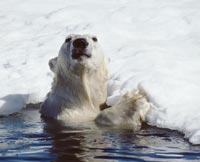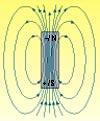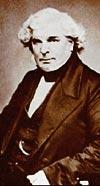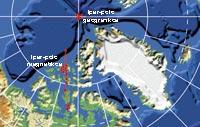Where is the North Pole?
2005/06/01 Imaz Amiano, Eneko - Elhuyar Zientziaren Komunikazioa Iturria: Elhuyar aldizkaria

Two are the definitions most used to locate the North Pole: geographical and magnetic.
It is called ‘north geographic pole’ to the point where the axis of rotation of the Earth coincides with the surface of the Earth, also called royal north. It is a point determined at a latitude of 90º N, from where, regardless of the direction, it moves to the south.
The north geographic pole is located in the sea, in the icy zone of the Arctic. It is not easy to get there and has always been attractive to adventurers. And, how not, it has also been discussed who came first.
Frederick A. According to Cook, he arrived on April 21, 1908, but on his return it took a year to unravel the ice sheet to return to ‘civilization’. Thus, he and his two ski expedition companions had to spend the winter in a cave of the island of Devon. Finally, in April 1909 it was possible to return to Greenland, where it was based on the idea that they were in the North Pole.
Robert E. Peary, for his part, proclaimed that he arrived at the North Geographic Pole on April 6 or 7, 1909, with five collaborators. One week after Cook returns. The debate has lasted many years and continues to exist, but, in general, the society of the time believed Peary, who for many years was the first to officially reach the North Pole. However, according to studies carried out in the 1980s, Peary was located 32 kilometers from the pole.
If this were so, Roald Amundsen would undoubtedly be the first to pass through the North Pole. He travelled by plane between Svalbard and Alaska in 1926.
North Magnetic Pole
According to the definition proposed by Sir William Gilbert in 1600, the position of the magnetic north pole would be: the point further north in which the geo-magnetic field enters the terrestrial surface with an angle of 90º. This definition is still in force today.

The magnetic field lines are those that make the electrons to pass from the pole(-) to (+), which border the Earth from the pole(-) to (+) and the axis that joins the two poles (+) to (-).
At present, these lines leave the north geographic pole, surround the Earth and head to the south geographic pole, so if we consider this and the definition of Gilbert, the north magnetic pole of the Earth is, in fact, the south geographic pole. However, we call the magnetic North Pole the closest magnetic pole to the geographical north.
However, it is much easier to say that the North and South magnetic poles are each of the two points that the compass points out in the North and South hemispheres.
On the other hand, the axis that joins the two geographical poles of the Earth and the axis that joins the two magnetic poles are not equal or totally parallel, being approximately 11.3º displaced. However, the magnetic poles are not fixed points, they move and, in addition, the two poles are not just in the opposite position: The magnetic north pole is closer to the geographic north (about 965 km) than the magnetic south. Therefore, the axis linking the two magnetic poles would not pass through the center of the Earth.
James Clark Ross discovered the magnetic north pole at the Adelaide cape of the Boothia peninsula on June 1, 1831. Roald Amundsen found him a little moved in 1903. It is currently located to the west of the Canadian island of Heiberg, at sea.
Between 2001 and 2003, the magnetic north pole moved 40 km/year. Displacement is a consequence of the variations of cast iron current in the terrestrial nucleus.
But the magnetic north pole also makes elliptical movements throughout the day, which move about 80 km from the maximum average position. This movement is a consequence of the distortions that the Sun produces in the geomagnetic field.
At present, what is known as magnetic north is located around the geographical north, but this situation is changing. In fact, throughout the history of the Earth, it has been several times in the geographical South. Finally, about 500,000 years ago they are invested. The poles are reversed by interrupting and resuming the circulation of liquids in the core of the Earth, but we still do not know why such circulation is interrupted.
They are not unique
In addition to these two ways of defining the North Pole, there are two other much less used: North Geomagnetic Pole and North Inaccessibility Pole. But we leave them for another.
James Clark Ross

Born in London on April 15, 1800. With only twelve years he entered the navy in the custody of his uncle John Ross. With him he made his first trip to the Arctic in 1818. Since then he made several trips to the Arctic. In one of them, on June 1, 1831, together with his uncle, he placed the magnetic north pole.
In 1834 he was appointed captain and participated in various investigations on the magnetic field.
He led several trips to Antarctica from 1839 to 1843, discovering in 1841 the Ross Sea, the Victoria territory, the Erebus and Terror volcanoes and the Ross ice layer.





